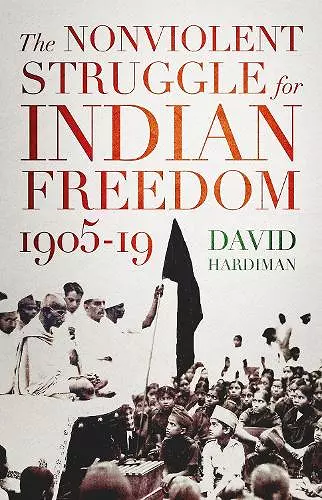The Nonviolent Struggle for Indian Freedom, 1905-19
Format:Hardback
Publisher:C Hurst & Co Publishers Ltd
Published:25th Oct '18
Should be back in stock very soon

Much of the recent surge in writing about the practice of nonviolent forms of resistance has focused on movements that occurred after the end of the Second World War, many of which have been extremely successful. Although the fact that such a method of resistance was developed in its modern form by Indians is acknowledged in this writing, there has not until now been an authoritative history of the role of Indians in the evolution of the phenomenon. Celebrated historian David Hardiman shows that while nonviolence is associated above all with the towering figure of Mahatma Gandhi, ‘passive resistance’ was already being practised by nationalists in British-ruled India, though there was no principled commitment to nonviolence as such. It was Gandhi, first in South Africa and then in India, who evolved a technique that he called ‘satyagraha’. His endeavours saw ‘nonviolence’ forged as both a new word in the English language, and a new political concept. This book conveys in vivid detail exactly what nonviolence entailed, and the formidable difficulties that the pioneers of such resistance encountered in the years 1905-19.
'Hardiman looks at the tangled web around the idea of ahimsaor non-violence both as a religious creed and its crossing over to the political domain at a time when organised mass mobilisation had just begun in India.'
'Hardiman demolishes the myth that Gandhian nonviolence succeeded in India because the colonial state observed the law. . . . This is a book every university should have in its library.'
‘Provides new insights into India’s nationalist struggle during the first two decades of the 20th century . . . this book is required reading for those who wish to understand not only the central role Gandhi played in the Indian nationalist struggle but also the cooperation and contestation required of mass movements involving different social groups.’
'Hardiman locates Gandhi in the little-known history of earlier Indian experiments with nonviolence, showing nonviolent resistance to be both creative and problematic, ambiguous and difficult, depending on the contexts in which it was practiced. A refreshing and illuminating approach.' -- Judith M. Brown
'Hardiman brings his fierce capacity for scholarly focus to the formative period of India's freedom struggle. A vital and illuminating study of building strategy and a mass base, the honing of the practices of resistance, and the construction of a whole philosophy that has come to be called "nonviolence".' -- Akeel Bilgrami
'An excellent contribution to the literature on nonviolent resistance.' -- April Carter
'A valuable contribution to our understanding of the contested nature of nonviolence in India before the better-known Salt March. An important read for anyone who is interested in putting civil resistance in its historical context.' -- Erica Chenoweth
ISBN: 9781849049702
Dimensions: unknown
Weight: unknown
288 pages